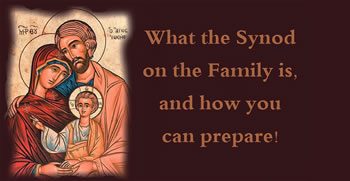Synod on the Family 2014-15
Early in October, almost 200 Bishops met in Rome to discuss the challenges facing modern families and the way in which the Church might assist the laity in meeting their vocation. Even though the laity were invited to submit views on the topic, the three week deadline they were given was quite unworkable and smacked of tokenism. Likewise, the inclusion of 23 lay observers among those to take part in the second stage of the synod in October 2015, with an invitation to one couple to provide testimony, is completely unsatisfactory.
Observer status is not enough. The subject is married life and married people should be full participants in the discussions and decision making.
Despite the urging of Pope Francis, it would appear that a majority of Bishops at this initial meeting resolved that the age old teachings of the Church, together with the man-made laws covering the marriage state, were still applicable. Further extended education for those who are, or who will be, married was considered to be all that was necessary to respond to peoples’ concerns over the reality of marriage.
It seems to me that, despite the progress achieved through Vatican II, many in authority still fail to recognise the covenantal nature of Marriage. So it is hardly surprising that the rules the Church continues to apply to the sacrament are structured as if Marriage were contractual. A marriage covenant comprises two promises; one made by a wife to her husband and matched by the second which is made by a husband to his wife. The only expectation within a covenant is the making and keeping of the promise; there can be no expectation of any “consideration” such as that which is integral to a contract. It is clear that covenants are completely different from contracts and so demand distinct discernments.
The sacramental covenant of marriage is evocative of the covenants which God established throughout the Old Testament and which were amended to include Gentile peoples. Current legalities tend to ignore these covenantal understandings which the Bishops of Vatican II identified when they declared that Matrimony symbolised the unity and faithful love between Christ and the Church.
Just before the Ascension, Jesus gave special powers to his disciples: If you forgive the sins of any, they are forgiven them; if you retain the sins of any, they are retained.” (Jn 20:23 NRSV). It is apparent this dictum is believed by many to mean that some will be forgiven their sins while others will not: but this interpretation runs counter to everything for which Jesus lived and died. He knew that anyone who seeks forgiveness would receive it for he also comprehended that evil would persist in being part of our world.
Our world will at least remain in its basic goodness until it will be perfectly restored. Though this is a second best outcome of Jesus’ efforts among us, and our rejection made it a second best, it is still a most wonderful reality to be achieved in time and history as we all wait for the realisation of complete redemption. 
I am encouraged when I hear of the day when the Lord binds up the injuries of his people, and heals the wounds inflicted by his blow (Isa 30:26 NRSV) for Isaiah, when coupled with John (cf 20:23), displays the essence of forgiveness. The Church needs to acknowledge such appreciations and welcome all who seek God’s gifts and consolations.
1 Jim Neilan, Challenges Facing Families. Tui Motu October 2014
2 Cristina Odone, Pope Francis Meets Opposition From Church Traditionalists, Dominion Post 21 October 2014, A7
3 Austin Flannery OP, Lumen Gentium: The Dogmatic Constitution on the Church. Para 11, 1988 Revised Edition; 362
4 Cyril J Connolly (MSC), The Gospel of John, The Human Story of Jesus, The Apprentice Son of God. Unpublished. 637.
Fr Jim is a retired Diocesan priest living on the Kapiti Coast.
Reprinted from Our Lady of Kapiti Parish Pastoral Pages by permission

 Entries(RSS)
Entries(RSS)